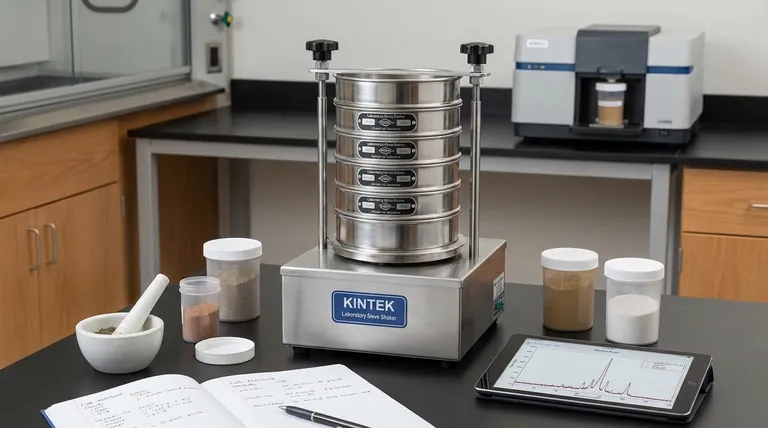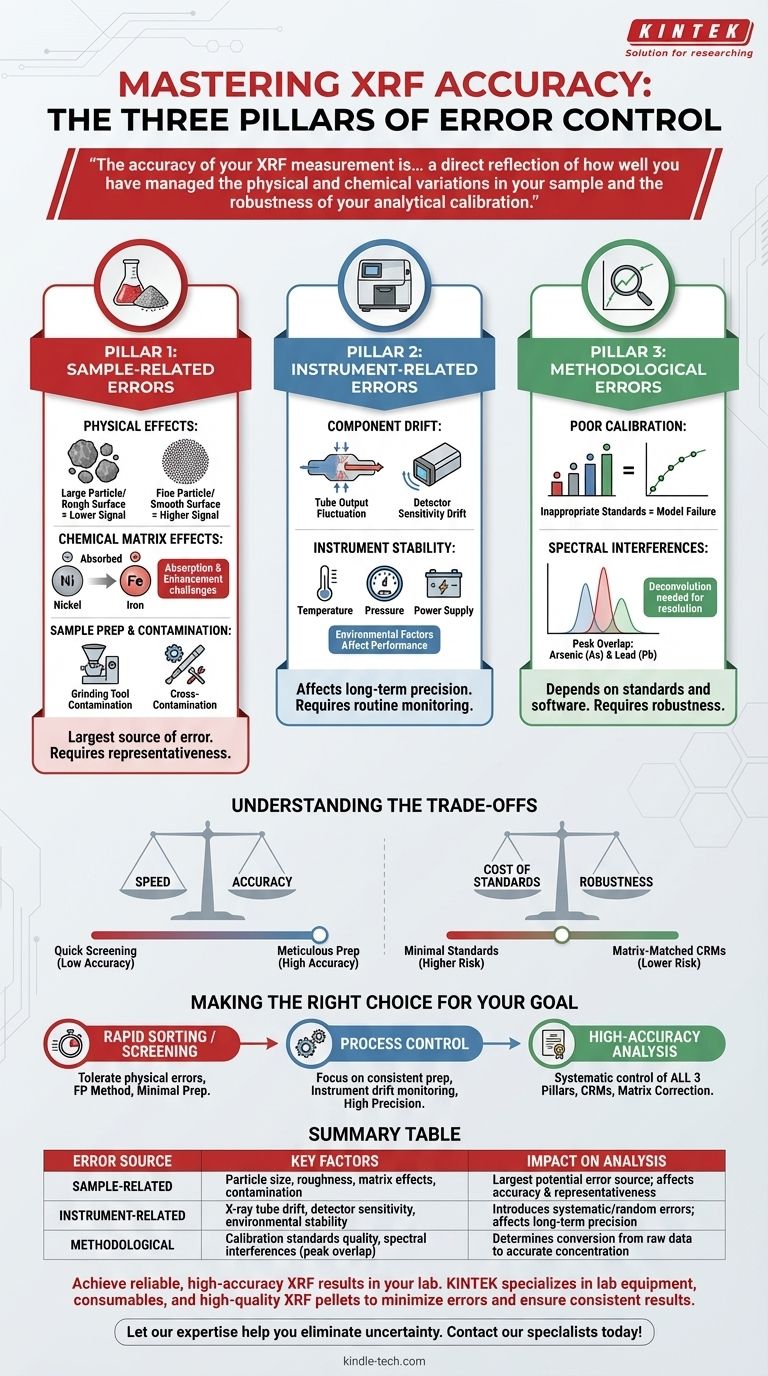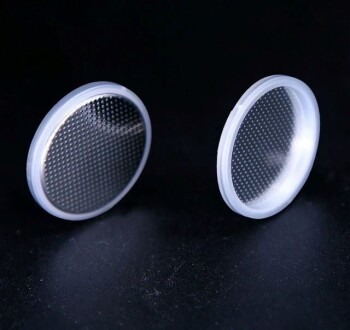Na análise por Fluorescência de Raios-X (XRF), os erros se originam de três domínios principais: a própria amostra (propriedades físicas e químicas), o hardware e a estabilidade do instrumento, e o método analítico ou calibração sendo utilizado. Embora fatores como a contaminação da amostra durante a preparação sejam significativos, um resultado verdadeiramente preciso depende do controle de variáveis em todas as três áreas.
A precisão da sua medição XRF não é apenas uma função da qualidade do espectrômetro, mas um reflexo direto de quão bem você gerenciou as variações físicas e químicas em sua amostra e a robustez de sua calibração analítica.

Os Três Pilares do Erro na XRF
Para obter resultados confiáveis, você deve entender onde potenciais imprecisões podem ser introduzidas. Podemos agrupar essas fontes em três categorias distintas.
Pilar 1: Erros Relacionados à Amostra
Esta é frequentemente a maior fonte de erro. O espectrômetro só pode medir a amostra que lhe é apresentada; se a amostra não for uma verdadeira representação do material a granel, os resultados serão falhos.
Efeitos Físicos
A natureza física da amostra influencia dramaticamente o sinal de raios-X. Os fatores chave incluem tamanho de partícula, rugosidade da superfície e uniformidade da amostra.
Partículas mais finas geralmente produzem um sinal fluorescente mais intenso do que as maiores. Uma moagem inconsistente ou uma superfície rugosa pode levar a erros significativos e imprevisíveis.
Efeitos de Matriz Química
Isso se refere a como outros elementos na amostra absorvem ou intensificam os raios-X do elemento que você está tentando medir. Este é um desafio fundamental na XRF.
Por exemplo, uma alta concentração de ferro absorverá fortemente a fluorescência do níquel, fazendo com que o níquel pareça menos concentrado do que realmente é. Esses efeitos devem ser corrigidos matematicamente.
Preparação e Contaminação da Amostra
A forma como uma amostra é preparada é um ponto de controle crítico. Erros introduzidos aqui são irreversíveis.
Como observado, a contaminação de equipamentos de moagem pode introduzir elementos estranhos. Da mesma forma, a contaminação cruzada de amostra para amostra pode ocorrer se as ferramentas de preparação não forem meticulosamente limpas entre os usos.
Pilar 2: Erros Relacionados ao Instrumento
Embora os espectrômetros XRF modernos sejam altamente estáveis, eles não são perfeitos. Variações de hardware podem introduzir erros sistemáticos ou aleatórios na análise.
Desvio de Componentes
Os dois componentes mais críticos, o tubo de raios-X e o detector, podem apresentar alterações de desempenho ao longo do tempo.
A intensidade de saída do tubo pode flutuar, e a sensibilidade do detector pode desviar devido a mudanças de temperatura ou envelhecimento. Essas mudanças são geralmente lentas e podem ser gerenciadas com monitoramento de rotina.
Estabilidade do Instrumento
Fatores como temperatura ambiente, pressão barométrica (em alguns sistemas) e estabilidade da fonte de alimentação podem afetar o desempenho do espectrômetro.
Manter um ambiente controlado para o instrumento é crucial para alcançar resultados analíticos de alta precisão e longo prazo.
Pilar 3: Erros Metodológicos e de Calibração
Mesmo com uma amostra perfeita e um instrumento estável, o resultado final depende inteiramente do método analítico e da qualidade da calibração.
Calibração Ruim
A calibração é o modelo matemático que converte as intensidades brutas de raios-X em concentrações de elementos. Este modelo é tão bom quanto os padrões usados para criá-lo.
Usar padrões de calibração insuficientes ou inadequados que não correspondem à matriz química de suas amostras desconhecidas é uma fonte primária de grandes erros analíticos.
Interferências Espectrais
Às vezes, as linhas características de raios-X de dois elementos diferentes são tão próximas que o detector não consegue resolvê-las. Isso é conhecido como sobreposição de picos.
Por exemplo, a linha K-alfa do arsênio se sobrepõe à linha K-beta do chumbo. Um software sofisticado é necessário para deconvoluir matematicamente esses picos e relatar um resultado preciso para cada elemento.
Compreendendo as Compensações
Controlar todas as fontes de erro pode ser demorado e caro. A chave é adequar seu rigor de preparação e análise ao seu objetivo específico.
Velocidade vs. Precisão
Uma análise rápida, "apontar e disparar", em uma amostra despreparada pode ser suficiente para identificação simples de material ou triagem.
No entanto, essa abordagem sacrifica a precisão e é completamente inadequada para controle de qualidade ou conformidade regulatória, onde a preparação meticulosa da amostra (como moagem e prensagem de pastilhas) é inegociável.
Custo dos Padrões vs. Robustez
A criação de uma calibração robusta requer uma ampla gama de materiais de referência certificados de alta qualidade e com matriz correspondente, o que pode ser caro.
Usar um conjunto mínimo de padrões ou depender da "padronização por tipo" (ajustar uma calibração de fábrica com uma ou duas amostras locais) é mais barato, mas introduz um risco maior de erro se suas amostras se desviarem dos padrões.
Fazendo a Escolha Certa para o Seu Objetivo
Sua estratégia analítica deve ser ditada pela pergunta que você precisa responder.
- Se seu foco principal é a triagem ou classificação rápida de materiais: Você pode frequentemente tolerar erros de efeitos físicos e usar um método simples de parâmetros fundamentais (FP), minimizando a preparação da amostra.
- Se seu foco principal é o controle de processo com um tipo de material conhecido: Sua principal preocupação é a precisão, então concentre-se na preparação de amostras altamente consistente e no monitoramento rotineiro do desvio do instrumento.
- Se seu foco principal é a análise de alta precisão para certificação ou pesquisa: Você deve abordar sistematicamente todos os três pilares, usando preparação meticulosa da amostra, materiais de referência certificados para calibração e software de correção de matriz.
Em última análise, alcançar a precisão na XRF é um exercício de controle sistemático, onde a compreensão das potenciais fontes de erro é o primeiro passo para eliminá-las.
Tabela Resumo:
| Fonte de Erro | Fatores Chave | Impacto na Análise |
|---|---|---|
| Relacionado à Amostra | Tamanho de partícula, rugosidade da superfície, efeitos de matriz química, contaminação | Maior fonte potencial de erro; afeta a precisão e representatividade do resultado |
| Relacionado ao Instrumento | Desvio do tubo de raios-X, sensibilidade do detector, estabilidade ambiental | Introduz erros sistemáticos ou aleatórios; afeta a precisão a longo prazo |
| Metodológico | Qualidade dos padrões de calibração, interferências espectrais (sobreposição de picos) | Determina a conversão de dados brutos em valores de concentração precisos |
Obtenha resultados XRF confiáveis e de alta precisão em seu laboratório.
O caminho para uma análise precisa requer o controle de variáveis em sua amostra, instrumento e método. A KINTEK é especializada em equipamentos e consumíveis de laboratório, atendendo às necessidades laboratoriais com pastilhas XRF, prensas e acessórios de alta qualidade, projetados para minimizar erros de preparação de amostras e garantir resultados consistentes.
Deixe nossa experiência ajudá-lo a eliminar incertezas. Entre em contato com nossos especialistas hoje para discutir sua aplicação específica e como podemos apoiar seus objetivos analíticos.
Guia Visual

Produtos relacionados
- Peneiras de Teste de Laboratório e Máquinas de Peneiramento
- Instrumento de peneiramento eletromagnético tridimensional
- Esterilizador de Laboratório Autoclave Esterilizador de Elevação a Vácuo Pulsado
- Fabricante Personalizado de Peças de PTFE Teflon para Pinças de PTFE
- Esterilizador de Laboratório Autoclave de Pressão Vertical a Vapor para Display de Cristal Líquido Tipo Automático
As pessoas também perguntam
- Quais são as peneiras de teste padrão para ASTM? Garanta a precisão com peneiras em conformidade com a ASTM E11
- Qual equipamento é operado para peneiras ao realizar testes de peneiramento? Obtenha Análise Precisa do Tamanho de Partículas
- Como usar um agitador de peneiras? Domine a Análise de Tamanho de Partículas para Controle de Qualidade
- Que tipo de materiais podem ser separados usando o método de peneiramento? Um Guia para a Separação Eficiente de Tamanho de Partículas
- Quais são as vantagens e desvantagens do método de peneiramento? Um Guia para o Dimensionamento de Partículas Confiável e Econômico


















